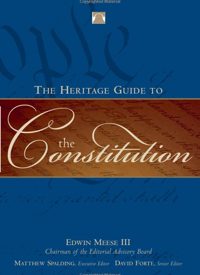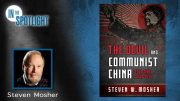
The Federalist Society has compiled a “Conservative & Libertarian Legal Scholarship: Annotated Bibliography” to collect what they deem to be the best legal analysis of every aspect of American law. Their recommended reading for constitutional law contains the following advice: “The Heritage Foundation has published a comprehensive Guide to the Constitution.… The Guide is so useful and concise a resource for understanding conservative and libertarian constitutional thinking that we have cited relevant pages throughout this section, in addition to other articles.”
Now keep in mind that this is the same Federalist Society that also advises young conservative and libertarian enthusiasts in their “Conservative & Libertarian Pre-Law Reading List” that “Neoconservative thinkers are an important intellectual force…. The godfather of the neocons is Irving Kristol. Policy Review recently published an excellent tribute to him, ‘Battler for the Republic,’ and some of his best work is collected in ‘Reflections of a Neoconservative: Looking Back, Looking Ahead.’”
This praise for neocons is featured on the same page with suggestions to look into the research of libertarian institutions such as the Foundation for Economic Education and the Ludwig Von Mises Institute. Talk about mixed signals! Referring to neocons and libertarians of the Austrian School as equally valid is akin to telling one that Thomas Jefferson’s The Declaration of Independence and Karl Marx’s The Communist Manifesto are equally important sources on political theory. So such high praise from the libertarian leaning but also neoconservative admiring Federalist Society that reaches so many young and developing minds on the Right, on such an important topic as the Constitution, deserves a thoroughly scrutinizing review.
The reader is told in the introduction that The Heritage Guide to the U.S. Constitution was written to “provide a brief and accurate explanation of each clause of the Constitution as envisioned by the Framers and as applied in contemporary law” that will be “accessible and helpful for informed citizens and students of the Constitution generally.” The Guide is certainly an ambitious effort that employed nearly 100 prominent and accomplished constitutional scholars to write in-depth essays about every facet of the U.S. Constitution. While it is amazingly informative, its fault lies in its overly strong deference to the national government which does not reflect the true nature of the ratification of our founding document.
The preface to the Guide explains that it utilized three sources: the records and debates of the constitutional convention, The Federalist Papers, and Joseph Story’s Commentaries on the Constitution of the United States. While the first two sources are vitally important, the third was published almost 30 years after the ratification and not only is it not legally binding whatsoever, it was also biased in favor of a nationalist vision. Story, along with Alexander Hamilton, John Adams, Daniel Webster, John Marshal,l and eventually Abraham Lincoln, all twisted the details of the ratification to argue for a nationalist and even a monarchist vision of a much stronger central government than what was actually created at the ratification.
Noted legal scholar of the day and prominent Jeffersonian republican Abel P. Upshur actually wrote an entire book to refute what he felt were misconceptions spread by Story’s Commentaries. Upshur criticized Story for construing the Constitution from the perspective of the small Federalist faction at the convention and ignoring the true historical nature of the ratification. Upshur argued that doing so betrays the very Constitution itself and enables a runaway central government to trample the sovereignty of the states as well as the individual rights of American citizens.
In Upshur’s book A Brief Enquiry into the True Nature and Character of our Federal Government, he wrote the “principle that ours is a consolidated government of all the people of the United States, and not a confederation of sovereign States, must necessarily render it little less than omnipotent. That principle, carried out to its legitimate results, will assuredly render the federal government the strongest in the world… Upon the theory that it possesses all the powers of the government, there is nothing to check, nothing to control it.”
Upshur even hypothesized what would happen under this scenario where the states had no recourse but to do as the federal government dictated. “Let it be supposed that a certain number of States, containing a majority of the people of all the States, should find it to their interest to pass laws oppressive to the minority, and violating their rights as secured by the Constitution. What redress is there, upon the principles of Judge Story? Is it to be found in the federal tribunals? They are themselves a part of the oppressing government, and are, therefore, not impartial judges of the powers of that government…. Under such a system as this, it is a cruel mockery to talk about the rights of the minority. If they possess rights, they have no means to vindicate them…. This is despotism of the worst sort, in a system like ours.”
Upshur’s criticisms still ring true today where the constitutional republic of old has been replaced by an all-powerful centralized super-state. This expansive growth in government only occurred because centralizers similar to Story were successful in changing the Constitution from being a restraint on federal power to instead being a source on unlimited federal power. A truly Jeffersonian republican analysis of the Constitution, which was part of this nation’s fabric up through the 18th century, would take into account the subjective understanding of the ratifiers which can be inferred by the public debates at the different state conventions as well as assurances as to the nature of the proposed central government made by advocates of ratification. This analysis always leads to the same conclusion: that the Constitution created an extremely limited central government entrusted only with specifically enumerated powers. The Guide’s failure to view the Constitution from this perspective is painfully noticeable in regards to its essay on the jurisdiction of the Supreme Court, which is much broader than what was originally authorized.
Still, the majority of the scholarly research in the book is extremely well done and certainly worth reading. It concisely makes the following astute and correct assertions: The General Welfare clause is “negative, not positive — a limitation on power, not a grant of power”; the spending clause of Article I is limited “only to further ends specifically enumerated elsewhere in the Constitution”; and the “Interstate Commerce” clause applied only to the free commerce of goods between the states rather than the open-ended grant of legislative power to Congress that it has been held out to be since the New Deal.
Indeed, they get the coinage clause right when they write, “it is likely that the Framers intended to prohibit the federal government from issuing bills of credit, just as they expressly barred the states from doing so.” They explain why the often utilized approach of incorporating the Bill of Rights against the states via the Fourteenth Amendment is contrary to the original intent. “Incorporation of the Bill of Rights would have immediately invalidated numerous practices of the states and that there was neither any indication that the framers of the clause expected this to happen nor any movement, after ratification of the Fourteenth Amendment, to alter such local practices to comply with the Bill of Rights.” They also harshly criticize the present bureaucratic chaos of the administrative state as obvious unconstitutional tyranny. Another excellent feature of the book is that the various writers bring the reader up to present day by reviewing landmark Supreme Court decisions, which is helpful to learn what passes for constitutional law these days as well as to illuminate how far away from the original intent the nine politically connected, life-time appointed lawyers on the Court have gotten.
Sadly, a major weakness of the book is the inclusion of analysis by dyed-in-the-wool neocons like John Yoo. Yes, that John Yoo. Yoo is the very same neoconservative attorney who worked in the Department of Justice’s Office of Legal Counsel for the administration of George W. Bush, and who drafted those infamous so called “torture memos” that are still being criticized today. Yoo, like many “conservatives” within the Heritage Foundation and the mainstream, neoconservative, beltway right believe in an imperial presidency imbued with king-like powers that would make even the Hamiltonian monarchists of the Founding blush. They embrace aggressive war and torture, which they rationalize through disingenuous constitutional arguments. So when the book assigns some of the most important topics in regards to constitutional law, such as the congressional power to declare war and the President’s powers as commander in chief, to a notorious neoconservative like Yoo, you have to take what they write with a grain, or perhaps a few tons, of salt. To Yoo’s credit, he does try to explain both sides of the argument, although somewhat limply, in his essays.
It would be good if Regnery, the book’s publisher, also published a Jeffersonian Republican Guide to the U.S. Constitution that illustrated a more vigorous and accurate view of state sovereignty. All-in-all though, it is a fascinating reference book that takes great pain to explore the original and true meaning of the U.S. Constitution. A portion of the book, like much of what comes out of the Federalist Society and the Heritage Foundation, which are both far too cozy with the neoconservative beltway right, has to be examined with a healthy dose of skepticism. But, for the most part, the book is worth reading for any knowledge-seeking constitutionalist. As the writers in the Guide say, constitutionalism will always be important not because it “remove[s] controversy or disagreement, but it does cabin it within a principled constitutional tradition that makes real the Rule of Law. Without that, we are destined, as Aristotle warned long ago, to fall into the ‘rule of men.’” And, as we have seen with the last Republican administration, those ‘men’ might just be pro-war, pro-torture neoconservatives.
The Heritage Guide to the Constitution, edited by Edwin Meese III, David F. Forte, and Matthew Spaulding, Washington, D.C.: Regnery Publishing, Inc., 475 pages; hardcover.



